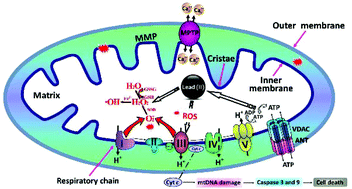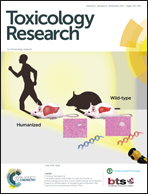Toxicity of Pb2+ on rat liver mitochondria induced by oxidative stress and mitochondrial permeability transition
Abstract
Pb2+ exposure in humans occurs mainly through air inhalation, food and water uptake which has been shown to be generally associated with numerous body functions such as the central and peripheral nervous systems, the red blood cells, the kidneys and the liver. It has been reported that the liver is the storage site and an important primary target in Pb2+ toxicity, and the hepatotoxicity of Pb2+ could be resulted from the impairment of the liver mitochondria. In this study, several mitochondrial dysfunctions following the addition of Pb2+ (10–160 μM) were investigated. We found that Pb2+ inhibited the enzyme activities of mitochondrial respiratory complexes and complex III was the major source of Pb2+-induced significant reactive oxygen species (ROS) formation. As a consequence, our results showed that Pb2+ induced significant progress in mitochondrial lipid peroxidation, adenosine triphosphate (ATP) consumption and glutathione (GSH) oxidation. On the other hand, Pb2+ induced marked changes in mitochondrial permeability transition (MPT) accompanied by mitochondrial swelling, mitochondrial membrane potential collapse, mitochondrial membrane fluidity decrease and cytochrome c (Cyt c) release. Additionally, several mitochondrial MPT inhibitors and chelators were utilized to determine the possible interaction sites of Pb2+ on mitochondria. In general, our data supported that the Pb2+-induced liver toxicity was a result of the disruptive effect on the mitochondrial respiratory complexes. This disruptive effect caused oxidative stress and MPT, which led to mitochondrial dysfunctions and even cell death signalling via mitochondrial permeability transition pore (MPTP) opening and Cyt c release.



 Please wait while we load your content...
Please wait while we load your content...